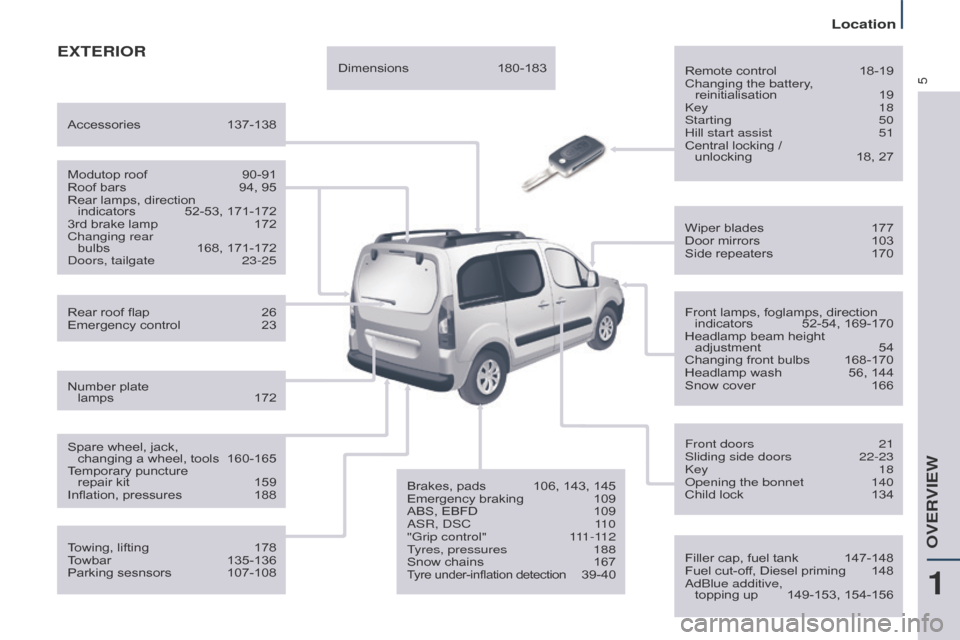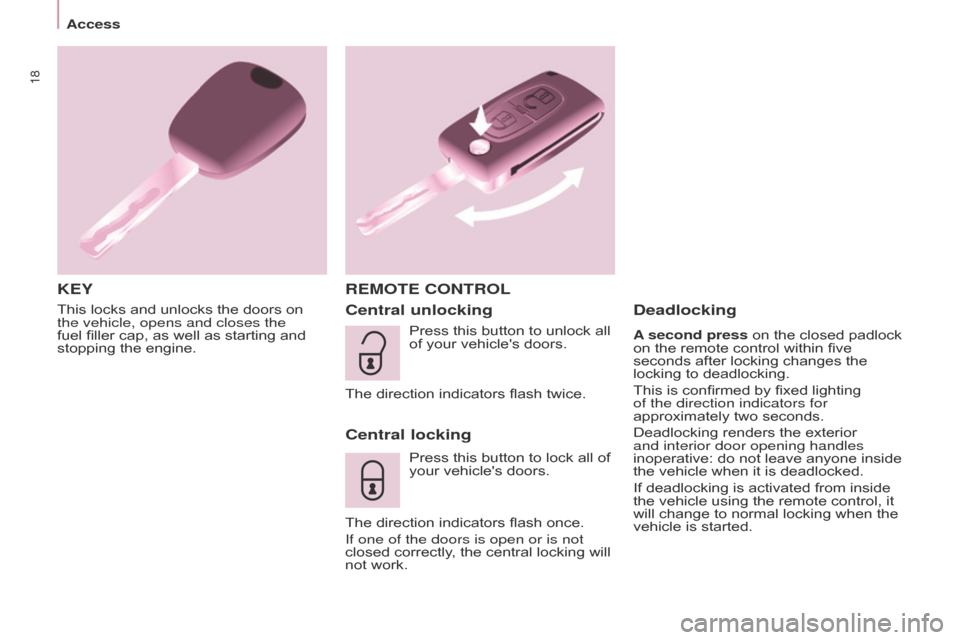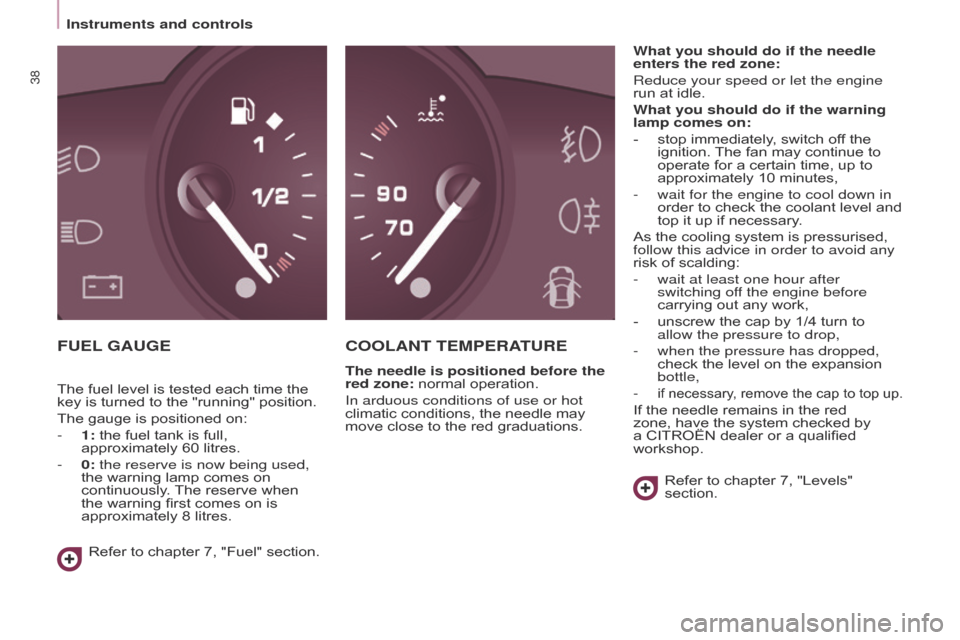fuel cap Citroen BERLINGO MULTISPACE RHD 2015 2.G Owner's Manual
[x] Cancel search | Manufacturer: CITROEN, Model Year: 2015, Model line: BERLINGO MULTISPACE RHD, Model: Citroen BERLINGO MULTISPACE RHD 2015 2.GPages: 276, PDF Size: 12.21 MB
Page 7 of 276

5
1
OVE
rVIEW
Berlingo_2_VP_en_Chap01_vue-ensemble_ed02-2014
EXtErIOr
Remote control 18-19
Changing the battery ,
reinitialisation
19k
ey
18
Starting
50
Hill start assist
51
Central
locking /
unlocking
18,
27
Filler
cap, fuel tank
147-148
Fuel
cut-off, Diesel priming
148a
dBlue additive, topping
up
149-153,
154-156
Wiper
blades
177
Door
mirrors
103
Side
repeaters
170
Front
lamps, foglamps, direction
indicators
52-54,
169-170
Headlamp
beam height
adjustment
54
Changing
front bulbs
168-170
Headlamp
wash
56,
144
Snow
cover
166
Front doors
21
Sliding side doors
22-23k
ey
18o
pening the bonnet
140
Child
lock
134
T
owing,
lifting
178
T
owbar
135-136
Parking
sesnsors
107-108
Rear
roof
flap
26
Emergency
control
23
Spare
wheel,
jack,
changing
a
wheel,
tools
160-165
T
emporary
puncture
repair
kit
159
Inflation,
pressures
188
Modutop
roof
90-91
Roof
bars
94,
95
Rear
lamps,
direction
indicators
52-53,
171-172
3rd
brake
lamp
172
Changing rear
bulbs
168,
171-172
d
oors, tailgate
23-25
Accessories
137-138
Number
plate
lamps
172 Dimensions
180-183
Brakes,
pads
106,
143,
145
Emergency
braking
109
ABS,
EBFD
109a
SR,
d
SC
1
10
"Grip control"
1
11-112
Tyres, pressures
188
Snow
chains
167Tyre under-inflation detection 39-40
Location
Page 20 of 276

18
Berlingo_2_VP_en_Chap03_Pret-a-partir_ed02-2014
This locks and unlocks the doors on the vehicle, opens and closes the
fuel filler cap, as well as starting and
stopping
the engine.
KEYr EMO t E c O ntr OL
c
entral unlocking
c
entral locking
Press this button to lock all of your vehicle's doors.
The
direction indicators flash once.
If one of the doors is open or is not
closed
correctly, the central locking will
not
work.
deadlocking
A second press on the closed padlock on the remote control within five
seconds
after locking changes the
locking
to deadlocking.
This
is confirmed by fixed lighting
of the direction indicators for
approximately
two seconds.
Deadlocking
renders the exterior
and interior door opening handles
inoperative:
do not leave anyone inside
the
vehicle when it is deadlocked.
If
deadlocking is activated from inside
the
vehicle using the remote control, it
will
change to normal locking when the
vehicle
is started.
Press
this
button
to
unlock
all
of
your
vehicle's
doors.
The
direction
indicators
flash
twice.
access
Page 34 of 276

Berlingo_2_VP_en_Chap03_Pret-a-partir_ed02-2014
32
Warning lamp isindicatesSolution - action
Front /
lateral
airbag flashing
or
remaining
on.a
failure of an airbag.Have
the system checked by a CITROËN dealer
or
a qualified workshop without delay.
Chapter
5, "Airbags" section.
Front
passenger's
airbag
deactivated on. the intentional deactivation
of this airbag in the
presence of a rearward
facing
child seat.Chapter
5, "Airbags" or "child safety" section.
Low fuel
level on with gauge
needle in the
red
zone.When
it first comes on,
there
remains around
8 litres
of fuel in the tank.
The distance you can drive
on this fuel depends on
your style of driving and the
engine
type.You
must fill up with fuel to avoid running out.
This
warning lamp comes on each time you
switch
on the ignition until you have filled up.
Capacity
of the tank: approximately 60 litres.
Never
risk driving until the tank is empty, this
could
damage the emissions and injection
systems.
flashing. cutting of
f of the fuel supply
following
a serious impact.Restore
the supply.
Chapter
7, "Fuel" section.
EOB
d
emission
control
system flashing
or
remaining
on.a
failure of the system.There
is a risk of damage to the catalytic
converter
. Have it checked by a CITROËN
dealer
or a qualified workshop.
Battery
charge on.
a fault in the charging
circuit. Check
the battery terminals, …
Chapter
8, "Battery" section.
flashing. placing of the active
functions on standby
(economy
mode).Chapter
8, "Battery" section.
remaining
on,
in spite of the
checks.an
ignition or injection
malfunction.Have
it checked by a CITROËN dealer or a
qualified
workshop.
Instruments and controls
Page 40 of 276

Berlingo_2_VP_en_Chap03_Pret-a-partir_ed02-2014
38
FuEL GAuGEcOOLA nt t EMPE r Atur E
the needle is positioned before the
red zone: normal operation.
In arduous conditions of use or hot
climatic
conditions, the needle may
move
close to the red graduations.What you should do if the needle
enters the red zone:
Reduce your speed or let the engine
run
at idle.
What you should do if the warning
lamp comes on:
-
stop
immediately, switch off the
ignition.
The
fan may continue to
operate
for a certain time, up to
approximately
10 minutes,
-
wait for the engine to cool down in
order
to check the coolant level and
top
it up if necessary.
As the cooling system is pressurised,
follow this advice in order to avoid any
risk
of scalding:
-
wait at least one hour after
switching of
f the engine before
carrying out any work,
-
unscrew
the cap by 1/4 turn to
allow the pressure to drop,
-
when the pressure has dropped,
check
the level on the expansion bottle,
-
if necessary, remove the cap to top up.
If the needle remains in the red zone,
have the system checked by
a
CITROËN dealer or a qualified
workshop.
Refer
to chapter 7, "Levels"
section.
Refer
to
chapter
7,
"Fuel"
section.
The
fuel
level
is
tested
each
time
the
key
is
turned
to
the
"running"
position.
The
gauge
is
positioned
on:
-
1:
the
fuel
tank
is
full,
approximately
60
litres.
-
0:
the reserve is now being used,
the
warning
lamp
comes
on
continuously
.
The
reserve
when
the
warning
first
comes
on
is
approximately
8
litres.
Instruments and controls
Page 149 of 276

Berlingo_2_VP_en_Chap07_Verification_ed02-2014
147
FILLInG WItH FuEL
Low fuel level
Filling
The fuel tank must be filled with the
engine off.
-
Open
the fuel filler flap.
-
Insert
the key, then turn it a quarter
turn.
-
Remove
the cap and hook it onto
the clip located on the inside of the
flap.
When
filling with fuel, a
mechanical
system prevents
opening
of the left-hand side door.
When
the fuel filler flap is open, ensure
that
no one tries to slide this door.
Once
the flap has been closed, the
sliding
side door may jam, push the
door
to close it then open it.
When
the
minimum
fuel
tank
level is reached, this warning
lamp
comes
on.
You then have
approximately 8 litres of
fuel
remaining.
Fill
up
without
delay
to
avoid
running
out
of
fuel.
Never
risk
driving
until
you
run
out
of
fuel
as
this
may
damage
the
emissions
control
and
injection
systems. A
label affixed to the inside of the flap
reminds
you of the type of fuel to be
used.
Y
ou must fill with at least 5 litres of fuel
for
it to be registered by the fuel gauge.
When
the fuel filler cap is opened,
there
may be a slight air suction noise.
This
vacuum is entirely normal and is
due
to the sealing of the fuel circuit.
When
filling the fuel tank, do not
continue after the 3rd cut-off of the
nozzle.
This
could
cause malfunctions.
The
capacity
of
the
fuel tank is
approximately
60
litres.
-
After
filling
the
fuel tank, lock the
cap
and
close
the flap.
Fuel used for petrol engines
The petrol engines are compatible with E10 bio-petrol (containing 10 %
ethanol), conforming to European
standards
EN 228 and EN 15376.
E85 type fuels (containing up to 85 %
ethanol) are reserved exclusively for
vehicles
marketed for the use of this
type
of fuel (BioFlex vehicles).
The
quality
of the ethanol must comply with
European
standard EN 15293.
Fuel
cHEcKS
7
Page 151 of 276

Berlingo_2_VP_en_Chap07_Verification_ed02-2014
149
AdBLuE® AddItIVE
A
nd S
cr
SYS t EM
FO
r B
L
u
E H dI dIESEL
E
n
GI
n
ES
To assure respect for the environment and conformity with the new Euro 6
emissions
standard, without adversely
af
fecting the performance or fuel
consumption
of Diesel engines,
CITROËN
has taken the decision to
equip
its vehicles with an effective
system
that associates SCR (Selective
Catalytic Reduction) with a particle
filter
(FAP) for the treatment of exhaust
gases.
Presentation of the Scr system
Using an additive called adBlue®
containing urea, a catalytic converter
turns up to 85% of nitrous oxides
(
no
x) into nitrogen and water, which
are
harmless
to
health
and
the
environment.
The
a
dBlue
® additive is held in a
special
tank
located under the boot
at
the
rear
of the vehicle. It has a
capacity
of
17 litres: this provides a
driving
range of about 12 500 miles
(20
000 km), after which an alert
is triggered warning you when the
reserve
remaining is enough for just
1
500
miles
(2 400 km).
d
uring each scheduled service of
your vehicle by a CITR
o Ë n dealer
or
a
qualified workshop, the
AdBlue®
additive
tank
is
refilled
in
order
to
allow
normal
operation
of
the
SCR
system.
If
the
estimated
mileage
between
two services is greater than
12 500 miles
(20
000
km),
we
recommend
that
you
go
to
a
CITROËN
dealer
or
a
qualified
workshop
to
have
the
necessary
top-up
carried
out.
o
nce the a dBlue
® tank is empty, a
system
required by regulations
prevents
starting
of the engine.
If the SCR
is faulty, the level of
emissions
from
your
vehicle will no
longer
meet
the
Euro
6 standard: you
vehicle
becomes
polluting.
In
the
event
of
a
confirmed fault
with
the
SCR
system,
you must go
to
a
CITROËN
dealer
or a qualified
workshop
as
soon
as
possible: after
a
running
distance
of
650 miles
(1
100
km),
a
system
will be triggered
automatically
to
prevent engine
starting.
AdBlue® additive
cHEcKS
7
Page 156 of 276

Berlingo_2_VP_en_Chap07_Verification_ed02-2014
154
topping-up the AdBlue® additive
Filling the adBlue® tank is an operation included in every routine service on
your vehicle by a CITR
o Ë n dealer
or
a
qualified
workshop.
n
evertheless, given the capacity
of
the
tank,
it
may
be necessary to
top-up the additive between services,
more
particularly
if an alert (warning
lamps
and
a
message) signals the
requirement.
Y
ou can got to a CITR o Ë n dealer
or
a
qualified
workshop.
If you envisage topping-up yourself,
please read the following warnings
carefully. Precautions in use
The
a dBlue® additive is an urea-based
solution.
This liquid is non-flammable,
colourless
and odourless (kept in a
cool
area).
In
the
event
of contact with the skin,
wash the af
fected area with soap and
water.
In
the
event of contact with the
eyes, wash (irrigate) the eyes with
large
amounts of water or with an eye
wash
solution for at least 15 minutes.
If a burning sensation or irritation
persists,
get
medical attention.
If
swallowed, immediately wash out the
mouth
with
clean water and then drink
plenty
of
water.
In
certain
conditions (high ambient
temperature,
for example), the risk
of
release
of
ammonia cannot be
excluded:
do not inhale the product.
Ammonia
vapour has en irritant effect
on
mucous
membranes (eyes, nose
and
throat).
k
eep
a
dBlue
® out of the reach of
children,
in
its
original bottle.
n
ever transfer
a
dBlue
® to another
container:
it
would
loose its purity. Use only
a dBlue
® additive that meets the
ISO
22241
standard.
n
ever dilute the additive with
water.
n
ever pour the additive into the d iesel
fuel
tank.
The supply in a non-drip bottle
simplifies
toping-up.
Y
ou can obtain
1.89
litre
(half
a
US gallon) bottles
from
a
CITROËN dealer or a qualified
workshop.Never
top-up from an
AdBlue®
dispenser reserved for heavy
goods
vehicles.
adBlue® additive
Page 157 of 276

Berlingo_2_VP_en_Chap07_Verification_ed02-2014
155
recommendations on storage
a
dBlue® freezes at about -11°C and
deteriorates above 25°C. It is
recommended
that bottles be stored in
a
cool
area and protected from direct
sunlight.
Under these conditions, the additive
can
be
kept for at least a year.
If the additive has frozen, can be used
once
it
has completely thawed out.
n
ever store bottles of
a
dBlue
® in
your
vehicle. Procedure
Before topping-up, ensure that the
vehicle
is parked on a flat and level
surface.
In wintry conditions, ensure that
the
temperature of the vehicle is
above -1
1°C. Otherwise, by freezing,
the
a dBlue
® cannot be poured into its
tank.
Park
your vehicle in a warmer
area for a few hours to allow the top-up
to
be
carried out.
F
Switch
off the ignition and remove
the
key. -
For access to the a
dBlue
® tank, open
the
filler
flap;
the
AdBlue® filler cap is located to the left of the fuel
filler
cap
-
T
urn
the
blue
cap
a
6
th of a turn
anti-clockwise.
-
Lift
off
the
blue
cap.
adBlue® additive
CHECkS
7
Page 186 of 276

184
Berlingo_2_VP_en_Chap09_Caract-technique_ed02-2014
EnGInE cHArActErIStIcS
The engine characteristics (capacity,
maximum power, maximum power
speed, fuel, C
o
2 emissions...) for your vehicle are given in the registration
document.
These characteristics correspond
to the values type-approved on a
test
bed,
under
conditions defined
in European legislation (
d irective
1999/99/EC).
For
more
information, refer to the
manufacturer's
website or sales
brochure
for
the
model. Contact
a
CITROËN
dealer or a qualified
workshop.
WEIGHtS And tOWE d LOA d S
The weights and towable loads for your
vehicle can be found on the vehicle's
registration
certificate.
These
values, expressed in kg, are
laos
present on the manufacturer's
plate
or label.
The
kerb weight is equal to the weight
without
load + driver (75 kg) + fuel tank
filled
to 90%.
The GTW and towed load values
indicated
are valid up to a maximum
altitude
of 1000 metres.
The
value of
the
towed load mentioned must be
reduced by 10 % for each additional
1000
metres.
With
load transfer, the braked trailer
weight can be increased, on condition
that
the equivalent of this load is
removed
from the vehicle so that the
GTW
is not exceeded. High
ambient temperatures
may
result in a reduction in the
performance
of the vehicle in
order
to protect the engine. When the
ambient
temperature is higher than
37
°C, limit the towed weight.
Towing with a lightly loaded
vehicle can adversely affect road
holding.
Towing
a trailer increases braking
distances.
When
towing, the maximum permitted
speed
is reduced (comply with the
legislation
in force in the country).
The
recommended nose weight is the downward force on the towball
(removable
with or without tools).
GVW: gross vehicle weight, the
maximum
authorised weight.
G
t W: gross train weight, the maximum
weight
for vehicle plus trailer.
Refer
to chapter 9, "Identification
markings"
section.
In
each country, it is imperative that
the towed loads authorised by local
legislation
are complied with.
T
o find
out your vehicle's towing capacities
and its gross train weight, consult a
CITROËN
dealer.
Weights